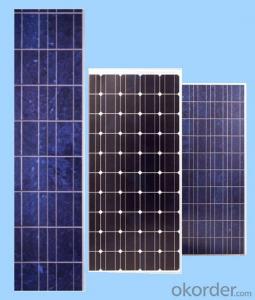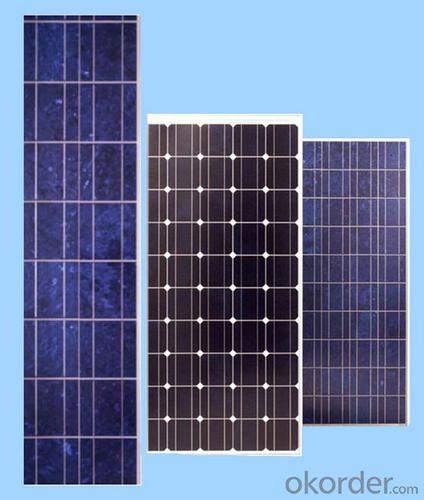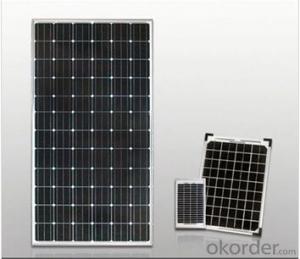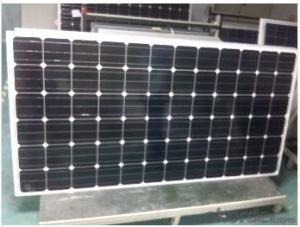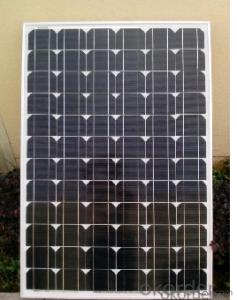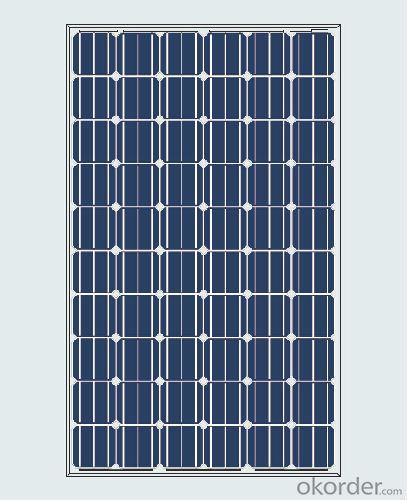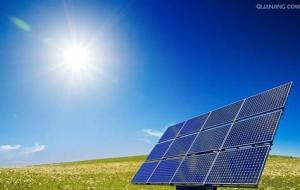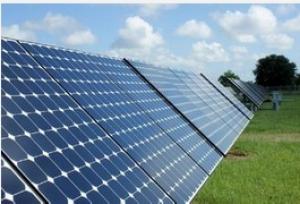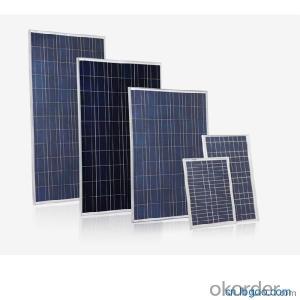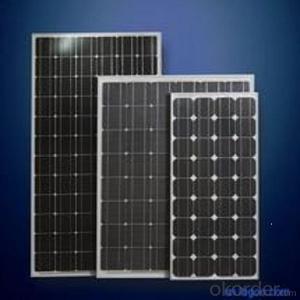Full Black Mono Solar Panels Solar Module 250W for Car Roof
- Loading Port:
- China main port
- Payment Terms:
- TT or LC
- Min Order Qty:
- 1 pc
- Supply Capability:
- 100 pc/month
OKorder Service Pledge
OKorder Financial Service
You Might Also Like
1.Structure of Solar Module Description
Quick Details
| Place of Origin: | Zhejiang China (Mainland) | Brand Name: | CNBM | Model Number: | SH-250S6-20 |
| Material: | Monocrystalline Silicon | Size: | 1650mm*992mm*45mm | Number of Cells: | 60(6x10) |
| Max. Power: | 250w | Certificate: | TUV |
2.Main Features of the Solar Module
Packaging & Delivery
| Packaging Detail: | 250w black solar panel package information, usually use carton, wooden case and pallet |
| Delivery Detail: | 25-35 days after all payment confirmed |
3.Solar Module Images
4.Solar Module Specification
Specifications
Dimensions 1650mm*992mm*45mm
Weight 19kg
Optimum Operating Voltage: 30.7V
Optimum Operating Current: 8.144A
250w full black mono solar panels specification as following
| Electrical Characteristics | |
| Model | SH-250S6-20 |
| Maximum Power at STC (Pamx) | 250w |
| Optimum Operating Voltage (Vmp) | 30.7V |
| Optimum Operating Current (Imp) | 8.144A |
| Open-Circuit Voltage (Voc) | 36.91V |
| Short-Circuit Current (Isc) | 9.153A |
| Solar Cell Efficiency (%) | 17.7 |
| Solar Module Efficiency (%) | 15.27 |
| Operating Temperature | -40to85°C |
| Maximum System Voltage | DC1000 |
| Maximum Series Fuse Rating | 15A |
| Power Tolerance | ±3% |
| STC:Irradiance 1000W/m2,Modules Temperature 25°C,AM=1.5 | |
| Mechanical Characteristics | |
| Solar cell | Mono-Crystalline156*156mm |
| No.of cells | 60(6×10) |
| Dimensions | 1650mm*992mm*45mm |
| Weight | 19kg |
| Front glass | 3.2mm tempered glass |
| Frame | Anodized aluminium alloy |
| Junction box | PV-YH0906 |
| Connector | Plug and socket |
| Output cables | PV 4.0mm2,0.9m |
| 1*20' | 294pcs |
| 1*40' | 616pcs |
| 1*40'HQ | 700pcs |
| Temperature Coefficient | |
| Nominal Operating Cell Temperature (NOCT) | 47°C±2°C |
| Temperature Coefficient of Pmax | -0.46%/K |
| Temperature Coefficient of VOC | -0.356/K |
| Temperature Coefficient of ISC | +0.024/K |
| Certificates | |
| TUV | |
| Warranties | |
| 10 years limited product warranty | |
| 15 years at 90% of the minimal rated power output | |
| 25 years at 80% of the minimal rated power output | |
5.FAQ of Solar Module
1. Q: Do you have your own factory?
A: Yes, we have. Our factory located in Jiangyin city, jiangsu province.
2. Q: How can I visit your factory?
A: Before you take off from your country, please let us know. We will show you the way,or arrange time to pick you up if possible.
3. Q: Could you print our company LOGO on the nameplate and package?
A: Yes, we can do that.
4. Q: Do you accept custom design on size?
A: Yes, if the size is reasonable.
- Q: I am curious about how much of the energy that a solar panel of a given size and capacity will produce in it's lifetime, and what fraction of that energy was required to produce it in the first place?
- The attached link is to an article from the 200 Home Power magazine. In that article the energy payback was found to be between 2 and 4 years. Newer panels are more efficient primarily because the silicon wafers used today are thinner. The silicon cell embodies most of the energy required to make a solar panel. Today most solar panels will produce the amount of energy required to manufacture them in between about 9 months and 2 years depending upon the specific technology used to make it. Solar panels are expected to produce energy for between 30 and 50 years. Therefore it takes around 5% of their total energy production to produce them. Note that these figures depend upon where the panels are installed. Panels in very sunny areas may generate more than 3 times the energy of panels in a cloudier area. Edit - The energy payback meta-study that carbonates references below mention one particular study Alsema (2000), which the authors used as a baseline to come up with their 4 year payback figure. These studies DO NOT assume ideal conditions. The Alsema study assumes an annual an irradiation of 700 kWh/m2/yr. That is the United States average irradiation and does take into account cloudy weather and the like. Under idea conditions the amount of energy collected can be almost twice as much. Albuquerque New Mexico is an example. The figures I mentioned above are recent values reported by several different panel manufacturers with whom I discussed the issue at the 2006 IEEE 4th World Conference on Photovoltaic Energy Conversion held this May. The very long payback times that carbonate highlights are almost certainly wrong. The study he references concludes that paybacks range between 2 and 8 years with 4 years being the most likely. In my opinion payback times are actually a fair bit shorter based on conversations with the manufacturers.
- Q: How can I start working as a solar panel installer/technician without years of education?
- The best suggestion I can give is to call solar installation companies in your area, and ask for their recommendation as to what to do. They may recommend a technical college with an appropriate program. With unemployment rising, new jobs in solar will likely be scarce for a while. You might also inquire at roofing companies. If you apply at a solar company, and can demonstrate that you already have roofing experience, that will be a plus.
- Q: I'm trying to charge rechargeable AA batteries with a solar panel. What guage wire should I use to connect the panel to the batteries? Should I use a diode to keep the batteries from overpowering the circuit? If so, what size? My panel is 4.8V 50mA.
- How photograph voltaic Cells artwork via Scott Aldous interior this text a million. advent to How photograph voltaic Cells artwork 2. Photovoltaic Cells: changing Photons to Electrons 3. How Silicon Makes a photo voltaic cellular 4. Anatomy of a photo voltaic cellular 5. power Loss in a photo voltaic cellular 6. photograph voltaic-powering a house 7. fixing photograph voltaic-power subjects 8. photograph voltaic-power experts and Cons 9. so a lot greater coaching 0. See all actual technological understanding articles you have probably seen calculators that have photograph voltaic cells -- calculators that for the period of no way decide for batteries, and specially circumstances do no longer even have an off button. as long as you have sufficient easy, they seem to artwork invariably. you need to have seen larger photograph voltaic panels -- on emergency highway signs and warning signs or call bins, on buoys, even in parking a lot to power lighting fixtures furniture. in spite of the undeniable fact that those larger panels are not as common as photograph voltaic powered calculators, they're accessible, and not that troublesome to locate in case you comprehend the place to look. There are photograph voltaic cellular arrays on satellites, the place they're used to power the electrical powered structures. you have probably additionally been listening to with reference to the photograph voltaic revolution for the final 2 many years -- the theory sooner or later we can all use loose electrical energy from the sunlight. this could nicely be a seductive promise: On a marvelous, sunny day, the sunlight shines approximately a million,000 watts of power in line with sq. meter of the planet's floor, and if we ought to deliver jointly all of that power we ought to actual power our homes and places of work for loose.
- Q: Can solar panels be installed on an agricultural greenhouse or nursery?
- Yes, solar panels can be installed on an agricultural greenhouse or nursery. In fact, it is a popular practice in many agricultural settings. Solar panels can provide renewable energy to power the greenhouse or nursery, reducing reliance on fossil fuels and lowering energy costs. Additionally, the panels can be mounted on the roof or ground around the facility, making efficient use of available space.
- Q: I'm going to pitch an idead to my school about switching to Solar Energy. What are positive and negative effects of the solar panels?Also what is the cost for installing them into a highschool?How much would the electricity bill decline afterwards?
- Solar panels can convert sunlight into electricity which can be used in daily life,solar panels utilize sunrays,it doesn't discharge any polluted gas,it is environment friendly,it is also cost effective,you can make money by sell the surplus electricity to your country, On question is that solar panles have to be use in where sun is abundent.
- Q: Can solar panels be installed on a car?
- Yes, solar panels can be installed on a car. Solar panels can be mounted on the roof or hood of a car to harness sunlight and convert it into electricity, which can then be used to power various systems or charge the car's battery. This can help reduce the reliance on traditional fuel sources and provide an eco-friendly alternative for powering vehicles. However, it's important to note that the amount of electricity generated by solar panels on a car may be limited due to the small surface area available for installation.
- Q: Can solar panels be installed on a gas station or convenience store?
- Yes, solar panels can be installed on a gas station or convenience store. In fact, many gas stations and convenience stores have already embraced solar energy as a way to reduce their carbon footprint and lower energy costs. By installing solar panels, these establishments can generate renewable electricity and potentially even sell excess power back to the grid.
- Q: Can solar panels be used to power a school?
- Yes, solar panels can definitely be used to power a school. Solar panels convert sunlight into electricity, which can be used to power various electrical systems within a school, including lighting, heating/cooling systems, computers, and other appliances. By harnessing solar energy, schools can reduce their dependence on traditional sources of electricity and contribute to a more sustainable and eco-friendly environment.
- Q: Is this a good kit for building a solar panel?
- Guide okorder /
- Q: How do solar panels affect the energy independence of a building?
- Solar panels can greatly enhance the energy independence of a building by converting sunlight into electricity. By generating their own clean and renewable energy, buildings with solar panels can reduce or even eliminate their dependence on traditional energy sources like fossil fuels or the grid. This not only reduces the carbon footprint but also provides a sustainable and reliable source of power, ultimately granting greater energy independence to the building.
Send your message to us
Full Black Mono Solar Panels Solar Module 250W for Car Roof
- Loading Port:
- China main port
- Payment Terms:
- TT or LC
- Min Order Qty:
- 1 pc
- Supply Capability:
- 100 pc/month
OKorder Service Pledge
OKorder Financial Service
Similar products
Hot products
Hot Searches
Related keywords
